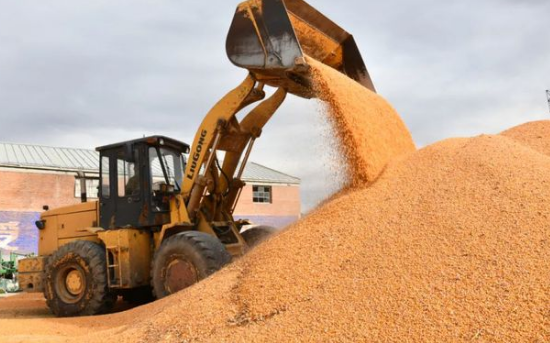摘 要
随着粮食产量日益提高,粮食安全标准愈加严格,粮食仓储问题逐步凸显。
产量增加的同时,政府对粮食的收购也愈加呈现出规模大、质量低、品种少的特点,但新的粮食安全标准则要求粮食仓储向多品种、高品质方向发展。因此政府开始提高粮食代储标准,却导致大批粮食企业仓库因不达标准而荒废,与此同时,农户粮食仓储规模也在大幅度下降。
在此背景下,基于契约农业的启发与现有农户-政府-企业的储粮模式,提出在政府引导下的农户企业合作进行的粮食仓储新模式。并运用混合策略博弈分析政府-农户-企业合作储粮模式运行的基础条件,再从政府与农户的角度展开动态重复博弈,得出“储粮收益与成本是农户储粮的决定性因素”这一结论;然后从农户与企业的角度进行动态博弈,分析加工型企业与代储型企业在农企合作中起到的决策性影响,并以实际案例紧跟其后进行分析,最后基于此提出促进农企合作进行粮食仓储的政策建议。论文的主要结论如下:
(1)现有粮食仓储模式中存在诸多问题。粮食仓储模式以农户自储、政府收储、企业代储为主,其中企业代储服务主体主要为中储粮总公司和地方政府。
在政府粮食仓储中存在的问题有两点,一是政策性粮食仓储过多,仓容不足,政府去库存压力大,二是大豆、杂粮等储量不足,不满足消费需求;在农户粮食仓储中存在的主要问题则是因仓储成本高、收益低而导致的粮食仓储规模大幅度减少;在企业粮食仓储中则分为代储型企业和加工型企业,对于代储型企业而言,问题是不满足承储资格,无承储任务,因此企业无资金投入维护,仓储设施老化,而加工型企业的困境则是应对原粮价格波动的能力不足。
(2)在农企合作进行的粮食仓储模式中,政府起主导作用,必须对农户和企业同时进行补贴,才能双向激发合作达成意愿;企业是发展的主体,政府对企业的补贴是企业是否代储的最大动力因素,补贴力度大,企业代储概率高,企业的效用就会增大;农户的参与度是合作关键,政府对农户的仓储补贴决定着农户效用。
(3)农户对未来市场的价格预期是农户是否合作储粮的关键因素。农户对未来的市场价格预期得到满足时,农户储粮成本和政府不采取补贴时农户所取得的收益决定了农户是否储粮,政府要想增加农户粮食仓储必须补贴数额大于储粮成本与收益。当农户对未来的市场价格预期得不到满足时,此时农户的预期会对农户储粮数量有跨期决策影响,若预期价格升高,农户则会增加此阶段粮食仓储量,以便于下一阶段将粮食售出获得更多收益,若预期价格下跌,农户为了防止利益受损会选择当期出售粮食。
(4)企业储粮效率决定了企业是否参与代储,决定了农户是否会与其合作。储粮效率差的企业可以通过粉饰自身效率吸引农户,但粉饰成本不能覆盖企业不代储时所得效益。

基于以上研究内容与结论,本文对促进农企合作进行粮食仓储提出了六个方面的建议:(1)政府应建立农户与企业的双向补贴机制,双向激发合作意愿;(2)应当发展与完善粮食交易信息平台,让农户对未来粮食市场价格产生合理预期(3)创建完善的企业代储制度,为农企合作奠定基础;(4)加强农企合作进行粮食仓储的宣传与引导,促进合作储粮模式的较快普及;(5)降低企业参与农户储粮的运营成本,提高企业收益与参与度;(6)建立储粮政策的反馈调节机制,不断优化合作储粮模式。
关键词 : 粮食仓储;农企合作;动态重复博弈;混合策略博弈。
Abstract
With increasing grain output and stricter food safety standards,the problem ofgrain storage has gradually become prominent.With the increase in output,thegovernment's grain purchases have increasingly shown the characteristics of large-scale,low-quality,and few varieties.However,the new food safety standards requiregrain storage to develop in the direction of multi-variety and high-quality.As a result,thegovernment began to raise the standard for storage of grain,but a large number of grainenterprise warehouses were abandoned because they did not meet the standards.At thesame time,the scale of farmers' grain storage was also greatly reduced.
In this context,based on the enlightenment of contract agriculture and the existingfarmer-government-enterprise grain storage model,a new model of grain storage underthe guidance of the government is proposed in cooperation with farmers andenterprises.The mixed strategy game is used to analyze the basic conditions for theoperation of the government-farmer-enterprise cooperative grain storage model,andthen the dynamic repeated game is carried out from the perspective of the governmentand farmers,and the conclusion is that“grain storage income and cost are the decisivefactors for farmers' grain storage”.Conclusion:Then,from the perspective of farmersand enterprises,a dynamic game is conducted to analyze the decision-making influenceof processing enterprises and storage-generation enterprises in the cooperation ofagricultural enterprises, and follow it up with actual cases. finally, based on this, policyrecommendations to promote agricultural enterprises to cooperate in grain storage areput forward. The main conclusions of the paper are as follows:
(1)There are many problems in the existing grain storage model. The grain storagemodel is mainly based on self-storage by farmers,government purchase and storage,andenterprise storage on behalf of the company.The main body of enterprise storage onbehalf of the company is the China National Grain Reserve Corporation and the localgovernment.There are two problems in government grain storage.One is that the policy-based grain storage is too much and the storage capacity is insufficient,and thegovernment is under pressure to destock; the other is that the reserves of soybeans andmiscellaneous grains are insufficient to meet consumer demand;there are in farmers'
grain storage.The main problem is that the scale of grain storage is greatly reduced dueto high storage costs and low returns; in enterprise grain storage,it is divided into storage-generation enterprises and processing-type enterprises.For storage-generationenterprises,the problem is not To meet the storage qualifications,there is no storagetask,so companies have no capital to invest in maintenance,storage facilities areaging,and the predicament of processing companies is their insufficient ability to copewith fluctuations in raw grain prices.
(2)In the grain storage model of agricultural enterprise cooperation,thegovernment plays a leading role,and it must provide subsidies to farmers and enterprisesat the same time in order to stimulate the willingness of cooperation in bothdirections;enterprises are the main body of development,and government subsidies toenterprises are whether the enterprises are acting on behalf of the enterprises.Thebiggest driving factor for storage is that the subsidy is large,and the probability ofenterprise storage is high,and the utility of the enterprise will increase; the participationof farmers is the key to cooperation,and the government's storage subsidies to farmersdetermine the utility of farmers.
(3)Farmers' expectations of future market prices are a key factor in whetherfarmers can cooperate in grain storage.When farmers’ expectations of future marketprices are met,the cost of farmers’ grain storage and the benefits that farmers obtainwhen the government does not take subsidies determine whether farmers store grain.Ifthe government wants to increase farmers’ grain storage, the subsidy amount must begreater than the cost and benefits of grain storage.When farmers’ expectations of futuremarket prices are not met,the farmers’ expectations will have an intertemporal impacton the farmers’ grain storage volume.If the expected price rises, the farmers willincrease the grain storage volume at this stage to facilitate the next step.In the first stage,selling grain to obtain more benefits. If the price is expected to fall, farmers will chooseto sell grain in the current period in order to prevent damage to their interests.
(4)The efficiency of enterprise grain storage determines whether the enterpriseparticipates in storage on behalf of the enterprise and determines whether the farmerwill cooperate with it.Enterprises with poor grain storage efficiency can attract farmersby decorating their own efficiency, but the cost of decorating cannot cover the benefitsof the enterprise when they do not store them.
Based on the above research content and conclusions,this article puts forward sixsuggestions for promoting agricultural-enterprises cooperation in grain storage:(1) Thegovernment should establish a two-way subsidy mechanism between farmers andenterprises to stimulate the willingness to cooperate in both directions;(2) It should be developed and improved The grain transaction information platform allows farmers tohave reasonable expectations of future grain market prices.(3) Create a completeenterprise storage system to lay the foundation for agricultural-enterprisecooperation;(4) Strengthen agricultural-enterprise cooperation to promote and guidegrain storage and promote cooperation The rapid popularization of the grain storagemodel;(5) Reduce the operating costs of enterprises participating in farmers' grainstorage, and increase the profit and participation of enterprises;(6) Establish a feedbackadjustment mechanism for grain storage policies and continuously optimize thecooperative grain storage model.
Keywords : grain storage;agricultural-enterprise cooperation;dynamic repeatedgame;mixed strategy game。
第一章 绪论
1.1、研究背景和意义。
1.1.1、研究背景。
自新中国成立以来,我国农业发展一直呈上升趋势,粮食产量、仓储规模、市场流通效率都与日俱增。相对于21世纪初我国市场化改革的全面推进与社会主义体制的逐步完善,现阶段我国市场经济已经高度活跃,粮食市场也呈现高速流动状态,随之而来的是越来越多粮食流向市场,浮现出藏粮于市的新常态。政府在粮食收获后,为保障农户利益往往采取托市收购政策,并委托部分企业进行代收代储,但由于粮食产量的提高,政府、企业、农户的粮食仓储方面都出现了诸多问题。
从我国政府层面看,政府粮食仓储规模过大,库存陈粮轮换困难,仓储结构不合理,粮食进口量大。2015年政府谷物储量达26122.90万吨,为近十年高峰,是2010年同期谷物储存量的1.95倍,仓储规模与日俱增。与此同时政策性粮食销售困难,2019年7月,国家有关部门共安排国家政策性粮油销售计划3579.8万吨,实际成交587.2万吨,成交率仅为16.4%,与6月相比成交量减少709.3万吨。水稻、小麦等谷物类粮食仓储量居高不下的同时,豆类却捉襟见肘,我国的大豆市场一直存在对外高依存现象,依存度已超过85%2018年我国的大豆消费总量有1.05亿吨,其中产量有1600万吨,进口量却达8806万吨。粮食安全的战略方针下,减少口粮对外依存度,避免因贸易摩擦而使国内粮食市场波动过大是未来发展的必要方向。
从企业层面来看,我国粮食企业中的储粮型企业问题最为凸显。储粮型企业是以替政府进行代收代储为主营业务的仓储型企业,主要集中于粮食主产区。在粮食安全标准从温饱向健康升级的大背景下,政府逐步提高储粮标准、降低储粮数量,对代储企业的收储资格审查也愈加苛刻,部分储粮企业因此失去储粮资格,供应链断裂,仓储设施处于荒废状态。如华嘉粮库,位于粮食主产区江苏省,拥有库房面积35000㎡,15万吨粮食仓储能力,自2017年中储粮南京分公司制发了《关于做好2017年中晚稻最低收购价委托收储库点预申报工作的通知》后,华嘉粮库仅存储上海市粮食仓储公司委托的3.5万吨谷物粮,仓容荒废率76.6%。储粮业务量下降的同时,仓储管理与设施维护成本并无减少,未来代储资格审查只会愈加严格。加工型粮食企业虽以粮食加工为主营业务,但作为制造型企业也存在粮食仓储需求,在政府对农户采取粮食托市收购政策的背景下,粮食加工企业存在无优质低价原粮困境,使成品粮无市场竞争力,企业发展日渐困难。
从农户粮食仓储视角来看,随着农村现代化的逐步推进与粮食市场流通效率的提高,农户粮食存储量的减少是环境因素与人为因素的共同作用结果。我国是农业大国,农村居民6.74亿,占总人口的50.32%,粮食产量的73%来自于传统农户和家庭农场等新型农户,剩余部分粮食产量来自于种粮企业。但2017年末山西省农户人均存粮量为154.59kg,贵州省农户人均存粮量为138.43kg,粮食主销区浙江省农户人均存粮量为10.33kg,相较于1995年存粮量降低了1397.28%,农户粮食仓储规模锐减。农村现代化的改革中,为改善整体农村风貌,农村房屋等基础设施建设也纳入政府规划中,传统粮食晾晒场地设施、违规建设仓库被拆除,国家粮食收购标准的提高都是农户将自身粮食库存向政府以及市场转移的重要因素。对于粮食流通效率高的省份而言,农户获得粮食的便捷度在提高,储粮成本也在提高,相比之下农户储粮意愿降低也是情理之中。但藏粮于市的粮食安全观要求我国广大的农户群体必须拥有部分粮食仓储规模以应对突发事件。
因此,在粮食安全要求和粮食市场化程度提高的背景下,如何将部分的粮食仓储工作从政府向社会转移,解决政府储粮压力,提高农户储粮规模保障农户种粮利益,解决企业发展困境,实现社会效益最大化,成为亟待解决的问题。
【由于本篇文章为硕士论文,如需全文请点击底部下载全文链接】
1.1.2 研究意义
1.2 国内外研究现状.
1.2.1 政府粮食仓储的相关研
1.2.2社会粮食仓储的相关研究
1.2.3农企合作模式相关研.
1.2.4博弈论在粮食问题的应用研究.
1.2.5研究述评
1.3研究内容和方法.
1.3.1 研究内容,
1.3.2 研究方法.
1.3.3 研究思路.
1.4 创新点.
第二章相关理论与概念界定.
2.1概念界定
2.1.1粮食.
2. 1.2仓储及仓储管理.
2.1.3粮食仓储
2.2理论依据
2.2.1博弈论
2.3本章小结,
第三章粮食仓储模式现状及问题分析.
3.1政府粮食仓储现状及问题分析
3.1.1中央粮食仓储运行机制与现状.
3.1.2地方政府粮食仓储运行机制与现状
3.1.3政府粮食仓储存在的主要问题
3.1.4 政府粮食仓储问题的理论分析
3.2社会粮食仓储现状及问题分.析
3.2.1农户粮食仓储现状.
3.2.2农户粮食仓储存在的主要问题.
3.2.3农户粮食仓储问题的理论分析.
3.2.4企业粮食仓储现状.
3.2.5企业粮食仓储存在的主要问题.
3.2.6企业粮食仓储问题的理论分析
3.3本章小结.
第四章农企合作粮食仓储模式的博弈分析.
4.1问题描述与农企合作粮食仓储模式假设.
4.1.1问题描述,
4.1.2农企合作粮食仓储模式假设.
4.1.3农企合作粮食仓储模式参与主体分析.
4.2政府-农户-企业的混合策略博弈
4.2.1博弈模型构建.
4.2.2博弈均衡分析.
4.3政府-农户的动态重复博弈.
4.3.1博弈模型构建.
4.3.2博弈均衡分析.
4.4农户企业的动态博弈
4.4.1博弈模型构建.
4.4.2博弈均衡分析.
4.5本章小结
第五章案例分析.
5.1案例背景
5.1.1案例目标环境因素.
5.1.2案例目标基本概况
5.2案例实证分析.
5.2.1案例运作状况
5.2.2农户仓储行为选择
5.23案例运作模式分析.
5.3本章小结
第六章促进农企合作粮食仓储的政策建议.
6.1 建立农户与企业的双向补贴机制.
6.2发展和完善粮食交易信息平台
6.3创建企业代储制度
6.4加强农企合作粮食仓储政策宣传与引导
6.5降低企业参与农户储粮的运营成本.
6.6建立储粮政策反馈调节机制.
6.7本章小结.
第七章 主要结论
本文以农户与企业合作储粮模式探究为目的,从政府、农户、企业储粮发展现状与问题出发,在分析存在的问题后发现,由于农户是否储粮既是问题的关键,也是农企合作储粮的前提,因此采用了博弈理论构建了政府与农户间的动态重复博弈,研究农户参与粮食仓储的决策因素,再构建政府-农户-企业间的混合策略博弈,分析合作的达成需要政府采取的行为措施以及影响企业参与合作的决定因素,最后以具体案例进行实证分析,并提出促进农企合作储粮的政策建议。主要研究结论如下:
(1)现有粮食仓储模式中存在诸多问题。粮食仓储模式以农户自储、政府收储、企业代储为主,其中企业代储服务主体为中储粮总公司和地方政府。在政府粮食仓储中存在的问题有两点,一是政策性仓储过多,仓容不足,政府去库存压力大,二是大豆、杂粮储存不足,不满足消费需求;在农户粮食仓储中存在的主要问题则是因储粮成本大、收益低而导致的粮食仓储规模大幅度减少;在企业粮食仓储中则分为代储型企业和加工型企业,对于代储型企业而言问题是不满足承储资格,无承储任务,因此无资金投入维护,仓储设施老化,而加工型企业的困境则是应对原粮价格波动的能力不足。
(2)在农企合作储粮模式中,政府起主导作用,必须对农户和企业同时进行补贴,才能双向激发合作达成意愿;企业是发展的主体,政府对企业的补贴是影响企业是否代储的最大动力因素,当补贴力度大,企业代储概率高,企业的效用就会增大;农户的参与度是合作关键,政府对农户的仓储补贴决定着农户效用。
(3)农户对未来市场的价格预期是农户是否合作储粮的关键因素。农户对未来的市场价格预期得到满足时,农户储粮成本和政府不采取补贴时农户所取得的收益,共同决定了农户是否储粮,政府要想增加农户粮食仓储必须补贴数额大于储粮成本与收益。当农户对未来的市场价格预期得不到满足时,此时农户的预期会对农户储粮数量有跨期决策影响,若预期价格升高,则农户会增加此阶段粮食仓储量,以便于下一阶段将粮食售出获得更多收益,若预期价格下跌,农户为了防止利益受损会选择当期出售粮食。
(4)企业储粮效率决定了企业是否参与代储,决定了农户是否会与其合作。储粮效率差的企业可以通过粉饰自身效率吸引农户,但粉饰成本不能覆盖企业不代储时所得效益。
参考文献.
[1]武平用完善的内控制度体系打造中储粮企业[J].商业会计2009,21):49 -50.
[2]郭佳华因有企业内部控制存在的问题及对策研究-以中储粮“硕鼠”事件为例[]现代经济信息2015,(1 5):39-40.
[3]刘鹏丁乐粮食收储制度改革与粮食仓储安全研究[]安徽农业科学,2016.,3):213-216.
[4]周贤模,王树,谢安忠.关于健全仓储粮管理制度与机制的研究[J].粮食问题研究,201201):46-51.
[5]泰中春完善我国粮食仓储管理制度[J]重庆理工大学学报(社会科学版) ,2010,24(7):1-7.
[6]杨羽字粮食安全视角下“中储粮”粮食仓储问题思考--基于多任务委托代理模型的分析[J].产业与科技论坛,2015,(1):95-95,96.
[7]邹胸怀强化风险管控优化财务职能[].商业会计,2011,(19) :6465.
[8]宋洪远.以市场化改革完善最低收购价政策[]人民论坛2012,(25):63-64.
[9]张晓山刘长全粮食收储制度改革与去库存[I]农村经济,2017,7):1-6.
[10]黄欢梅粮食企业构建多元购销模式浅析一---以中国仓储粮管理总公司为例[J]财经界(学术版),201 2(07):121+123.
[11]侯庆视.浅谈中储粮直属库与分库会计业务核算程序[凹] .商业会i计,2010,(21);62-63.
[12]周惠提升直属库财务缋效评价效果的思考[J].商业会计2011,22):7475.
[13]黄欢梅EVA业绩考核在中储粮直属库中的应用[]商业会计,201 1,33):61-62.
[14]徐湘洪加强财务风险控制提高粮库管理水平]商业会i计,2010(15)79 -80.
[15]于春雨.现阶段中储粮直属库账务统筹运用的探讨[J]商业会计,2011,(1).75-76.
[16]李江培.直属库会计基础:工作存在的问题及对策[]商业会计2011,15);66-67.
[17]娄源功基于粮食安全的国家粮库建设布局研究[]农业经济问题,2001225)7-11.
[18]曾丽瑛中国粮食供求状况和因家调控市场政策措施[]农产品加工创新版,2009,(7):46.
[19]朱玉东梁杰,王清清地方政府视角下我国粮食仓储体系分析[J]南方农业,2015,921):172-174.
[20]安彦青.完善地方仓储粮食政策性补贴资金的建议[].商业会计,2010,(16):51-52.





